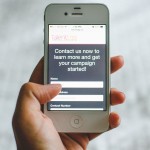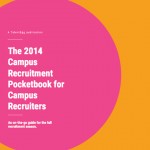The room is booked, registration numbers are looking good, and you’re ready to make a lasting impression on the students attending your employer information session.
As an integral part of your campus recruitment efforts, hosting an on-campus info session is an excellent way to connect with potential candidates and establish your employer presence at the grassroots level.
But before you get started, we have to ask—how good is your slideshow presentation?
Effective presentations have the ability to capture audience attention and encourage them to embrace your ideas. With a room full of curious, career-focused Gen Y talent, you want to ensure your presentation (and your employer brand) is memorable—in the best way possible.
How do you create a persuasive, compelling slideshow presentation? Read on:
1. Have a clean design
Gen Y has been labelled many things, and design-savvy is one of them. From mobile apps to business cards, they’ve formulated particular opinions about what looks good and what doesn’t.
Meet their expectations with your template design. Think a plain white slide with Comic Sans font will hold their attention? Think again. Gen Y is stimulated by aesthetically pleasing, organized information. They engage with dynamic visual material on a daily basis, meaning they don’t want to sit through a static, lacklustre presentation.
If you’re responsible for creating your own slide deck, pay attention to the overall layout and theme of your presentation. Keep your slides simple and use bright, contrasting colours to add dimension and emphasize key terms and phrases. Photos should be limited to one or two per slide when accompanying text, and interesting typography should be explored. Avoid using animated elements (these are outdated and distracting) or excessive branding in your design. Most important? Be consistent with your formatting!
If your creative team is responsible for building out your deck, work with them to incorporate Gen Y friendly ideas into your overall framework.
2. Be concise
Growing up with the rise of social media has influenced the way Gen Y consumes information (which makes sense in a world limited to 140 characters or less). Concise, easily digestible information is the best way to communicate your ideas to the students attending your info session.
Not sure how to focus your messaging? One way to frame your thoughts is by using the 10/20/30 Rule by Guy Kawasaki. The venture capitalist coined the idea back in 2005 as a way to change the way entrepreneurs pitched proposals, and it has since become an accepted practice for any kind of presentation.
The basic idea is as follows: your presentation deck should never be more than 10 slides, your presentation itself no more than 20 minutes, and your text at least 30-point in size.
Kawasaki argues that because the majority of people have trouble absorbing more than 10 concepts in one sitting, 10 slides is a good benchmark. Twenty minutes is an adequate amount of time to formally present your ideas while leaving plenty of room for a healthy discussion afterwards. 30-point font ensures that your messaging is easy-to-read and helps you to be succinct (bigger font = less space on slide). Employing the 10/20/30 Rule will help to ensure that your message is well-received.
3. Tell a story
Think of your presentation as an extension of your employer brand: you want students to leave your info session believing that your organization is the best place to hatch a successful career.
To do that, you need to capture the attributes that make your organization unique, and the best way to convey those ideas is through the people who already work there.
Storytelling is an incredibly effective presentation style. It can help to further engage your audience and can help them develop an emotional connection to your ideas. Utilize anecdotes, testimonials and other personal cues from your workforce to build out a slideshow presentation that engages students on a personal level. Students can sense when an employer brand is genuine and authentic. Don’t be afraid to infuse personality into the professional! If possible, collect quotes from employees your student audience can relate to, like student interns, recent hires or established Gen Y employees in their early careers.
4. Use media
When presenting to a Gen Y audience, you want to include visual aids to help explain and connect your ideas to your audience.
Don’t rely on your information (re: text) to speak for itself. Show Gen Y why they should work at your organization. Literally.
High-quality photographs, sound clips, graphics and video content are multidimensional aspects that can really enhance your presentation. Slides over saturated with text are overwhelming and can lead students to perceive your organization as out-of-touch with the latest trends in technology and design (something they inherently value).
Use photographs of real employees whenever possible—stock images are easy to spot and make your presentation look unrealistic or tacky. You can also embed your TalentEgg video content into your presentations to complement your points and answer some of the questions students may have about your organization, like what employees like most about your workplace culture.
5. Try a fresh alternative
It goes without saying: Gen Y is on the cutting edge of everything, including presentation platforms. From projectors to iPads, students are utilizing technology to present their classwork in new ways.
Microsoft PowerPoint has always been the universal standard for presentations, but there are a few fresh alternatives on the scene that can help you take your employer info session from good to egg-ceptional. Using these platforms is a great way to add a dynamic element into your info session, impress your Gen Y audience and make your employer brand look in-touch with the technology trends that students are familiar with.
Prezi, emaze, and Slides are online deck-creating software that up the ante on functionality. They are free to use (though upgrades for additional features or storage are also available for certain platforms) and have a myriad of inspired features to explore, like multi-device access or CSS customization.
Looking to build a presentation from scratch? While the alternatives are slightly more involved than PowerPoint, they’re also user-friendly and offer many resources to help you create your masterpiece. Want to create a cool presentation on the fly? Almost all of the alternatives have professional, Gen Y approved templates and themes to implement if that’s more your scene.
Discussion: What’s your #1 piece of presentation advice?






Leave a Reply
You must be logged in to post a comment.